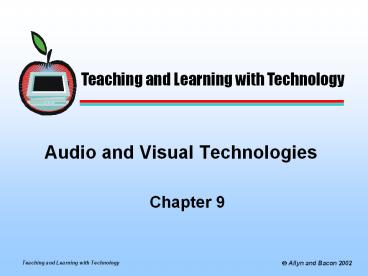Audio and Visual Technologies - PowerPoint PPT Presentation
1 / 18
Title:
Audio and Visual Technologies
Description:
Teaching and Learning with Technology Audio and Visual Technologies Chapter 9 Audio in Teaching and Learning Listening includes both hearing and comprehending audio ... – PowerPoint PPT presentation
Number of Views:86
Avg rating:3.0/5.0
Title: Audio and Visual Technologies
1
Audio and Visual Technologies
Teaching and Learning with Technology
- Chapter 9
2
Audio in Teaching and Learning
- Listening includes both hearing and comprehending
audio - Effective listening for learning includes
- Accurate hearing
- Focused listening
- Reinforcement to stimulate neural connections
3
Traditional Audio Media
- Audio Cassette
- Economic, durable, and easy-to-use
- Uses magnetic tape to record voice, music, and
other sounds - Can be used in centers, small groups, or large
group instruction to add audio elements - May be used for talking books, multimedia kits,
oral histories and journals
4
Traditional Audio Media
- Broadcast Audio
- Received via radio or cable audio channels
- Enhances content with current events, music, and
foreign language - Telephone
- May be used to bring speakers in via phone
- Can also be used to include home-bound students
in class activities
5
Digital Audio Media
- Optical Media (CD-ROMs)
- Offer better clarity and greater storage capacity
when compared with traditional audio media - Easier to directly access target audio for replay
- With CD-Rs and CD-RWs you can also record audio
6
Digital Audio Media
- Internet Audio
- You can download audio rather than acquire CDs
- While audio clips in Wav and MP3 formats are
widely available, MP3 is gaining popularity
because it require smaller files - You will need media players (typically free) to
play back these files
7
Digital Audio Media
- MP3 Files
- Sometime include visualizations (graphics or
video) displayed during audio playback - MP3 players usually include recording and
playback controls to enhance quality and control
sequences - Typically music but may also include any other
audio elements
8
Digital Audio Media
- Internet Radio
- Using streaming media, many radio stations
simultaneously broadcast via the Web as well as
the airwaves - National and international stations outside the
local area are now available via the Web - Include music, news and talk stations from around
the world
9
Visual Communication
- Visual literacy is the ability to correctly
interpret visual signals - Visual experiences in education should be
designed to encourage visual literacy - Awareness of effective visual design helps to
impart visual literacy skills to students
10
Visual Communication
- Visual Design Basics
- Visual design includes text, visual elements, and
affective elements - Text refers to all aspects of text including
fonts, spacing, color, and sizes - Visual elements include graphics, symbols, real
objects, and organizational elements - Affective elements are visual components that can
elicit responses from viewers
11
Visual Communication
- Visual Design Guidelines
- Relevance
- All elements should add clarity to the visual
- Graphics should accurately illustrate the
intended concept - Coherence and Consistency
- Include only those elements that support the
message - All elements should be consistent with each other
and with the message
12
Visual Communication
- Visual Design Guidelines
- Proportion and Contrast
- Proportion refers to relative size of elements
- Contrast refers to the arrangement and balance of
the various elements - Use proportion and contrast to draw attention to
the most significant aspects of the message - Unity and Direction
- Elements must work together to communicate the
focus of the message and then to direct the
viewer to subsequent components
13
Traditional Visual Media
- Non-Projected Visuals
- Real objects include all objects that can be
brought into the classroom and used as a visual
enhancement - Models are 3-D representations of real objects or
concepts - Exhibits are displays or dioramas that are
created or arranged to illustrate instructional
concepts
14
Traditional Visual Media
- Non-Projected Visuals
- Print Materials include commercial and
teacher-made paper materials - Graphics and Photos are pictorial images used to
illustrate and clarify - Technologies for Non-Projected visuals include
- Chalk Boards
- White Boards
- Electronic White Boards
- Bulletin Boards
- Flip Charts
- Magnetic Boards
15
Traditional Visual Media
- Projected Visuals and their Technologies
- Overhead Projectors
- Shine light through transparencies for large
group projection of the images - Transparencies can be drawn or printed with ink
jet or laser printers the right transparency
film must be used with each - Commercial transparencies are frequently
available with texts or in supplemental books - Transparencies can also be created with common
software such as word processors
16
Traditional Visual Media
- Projected Visuals and their Technologies
- Slide Projectors
- Slides are small film images mounted in cardboard
which are typically organized in trays - Photographic slides remain popular because they
offer the most accurate, high resolution color
images - Slides require limited equipment for projection
but may deteriorate with age
17
Non-traditional Visual Media
- Digital Projectors
- Used to project digital images from computers,
digital cameras, and photo CDs - Allow for large group display of anything digital
- Document Cameras
- Video camera mounted on a stand to capture and
display live video images - May use monitor or digital projector for display
- Can be use to zoom in on a real time
demonstration or to share images of small objects
18
Multimedia
- Combining multiple media into a single integrated
whole - Multimedia includes audio and visual elements
typically stored on a CD-ROM with hyperlinks
between the elements - Multimedia must be carefully evaluated for good
design and appropriate and meaningful audio and
visual elements































